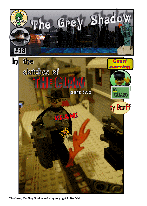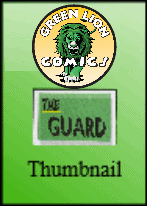
****LEGOģ is a trademark of the LEGO Group, which does not sponsor, authorise or endorse this web site. Visit the official LEGO website at http://www.LEGO.com.****

***Please note that I am using a standard thumbnail image for all the full size pictures on this page. This is purely being done to save myself sometime.***
 cover #18.  inside cover #18.  page ten.  page eleven.  page twelve. |
 page thirteen.  page fourteen.  page fifteen.  page sixteen.  page seventeen. |
 page eighteen.  page nineteen.  page twenty.  page twenty-one. |
 page twenty-two.  page twenty-three.  page twenty-four.  page twenty-five. |
 page twenty-six.  page twenty-seven.  page twenty-eight. |
Did anyone spot my version of a famous painting in the story? Iíll come back to that later. I decided to set this story in winter with snow on the ground. (I made use of transparent blue Lego tiles and frozen steams of water to indicate that the temperature was below freezing. This was relevant for the finale of the story). This involved extra work Lego building wise, (white slopes replacing other coloured slopes on existing houses, creating snow roads, pavements and so on), but worth it in the end.
The result of all this extra building and setting up the street scene the way I required, meant that I didnít finish till the light had gone for the day. I decided to start shooting anyway under artificial light. This produced photographs with a curiously warm, yellowish appearance. No doubt helped by the large quantities of white Lego. This type of light I have seen before on overcast winter days, where the skies are snow laden. So it didnít seem unreasonable to continue shooting the outdoor scenes using these lighting conditions.
Part one and the early pages of part two of The Claw deliberately avoided mentioning who The Grey Shadow was or even if they were male or female. (Although it wasnít too difficult to work out the latter, hopefully some readers were left in suspense regarding the former question). The head of The Grey Shadow is from the Madam Hooch mini-figure from the Harry Potter series.
Hopefully, both the covers for The Claw parts one and two (especially part two), will have provided a 'hook' to persuade readers to turn the page and continue reading the story.
This long story (twenty-eight pages long), is the longest one I have so far attempted. I had the plot worked out, but several sections were changed, amended or deleted as the story progressed. New sections being added as ideas came to mind. For example, the ending changed significantly. Originally I was going to make more use of the Clawís vehicle, but I found I wasnít quite sure or confident about how to take the necessary shots of the vehicle. It didnít help that The Claw character was hidden from view when the vehicle was viewed from the front. So I kept the ending shorter than originally planned.
Iím quite pleased with the several set-pieces I created for example, DeWinterís office and the sequence of panels for the Grey Shadow going into action and the finale fight scene.
Back to the painting I mentioned at the beginning. I e-mailed various people to see if anyone could recognise and name the painting. Only one person named the painting correctly. (But better than none. I donít know if that is a reflection on their lack of painting knowledge or my model not being accurate enough). Itís my version of Edward Hopperís Nighthawks. Re-creating this scene was never in my original script for this story. I had been thinking about creating Lego versions of various paintings for some time now. The first one I chose is scheduled to appear in a story in a couple of months time. So it was a complete surprise to me to find Nighthawks popping up in this story and being crucial to the storyís plot. The build wasnít too difficult, although getting the lighting correct took some time. I had to re-create the dinerís side window using the software I use to create my comics. My camera kept focusing on the transparent Lego glass window. (I should have thought about that).
Quite a few new characters were introduced into this story, some having small parts, others crucial to the plot. Detective Velander (her surname is an anagram of lavender), was a very late addition to the story. As regular readers of these story notes know, I donít produce a full story board for each story. I have a rough idea of the story and then amend or add to it as the story progresses. Itís quite an interesting way of working, in that I donít always know how a story will work out.
Green Lion Comics, story and characters © Adrian Banfield, 2015.
